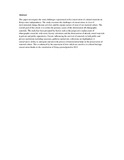| dc.contributor.author | Wahome, E.W. | |
| dc.date.accessioned | 2014-04-25T07:27:41Z | |
| dc.date.available | 2014-04-25T07:27:41Z | |
| dc.date.issued | 2013 | |
| dc.identifier.citation | Wahome EW. "An Assessment of the Challenges Associated with the Loss of Tangible Heritage in Kenya." International Journal of Arts and Commerce. 2013;Vol. 2 (No. 9 ):77-92. | en_US |
| dc.identifier.uri | http://www.ijac.org.uk/images/frontImages/gallery/Vol._2_No._9/7.pdf | |
| dc.identifier.uri | http://hdl.handle.net/11295/65986 | |
| dc.description.abstract | This paper investigates the main challenges experienced in the conservation of cultural materials in Kenya
since independence. The study examines the challenges of conservation in view of environmental change,
human activities and the organic nature of most of our material culture. The overall goal of this article is to
isolate the primary causes of the deterioration of ethnographic materials. The study has been prompted by
factors such as the progressive replacement of ethnographic materials with exotic factory substitutes and the
deterioration of already stored materials in private and public repositories. Factors influencing the survival
of materials in both public and private institutions including museums, galleries and private collections are
highlighted. A conservator’s ability to anticipate and arrest the process of deterioration helps in the
preservation of material culture. This is enhanced by the enactment of laws which are sensitive to cultural
heritage conservation thanks to the constitution of Kenya promulgated in 2010 | en_US |
| dc.publisher | University of Nairobi | en_US |
| dc.title | An assessment of the challenges associated with the loss of tangible heritage in Kenya | en_US |
| dc.type | Article | en_US |


